Steam 's 2017 game sales increased by 22% to 460 billion yen, while it is not easy for indie game makers On the one hand year

Originally should be unpublishedSteamA site that collects data such as the number of sales and sales data by its own method "Steam Spy"Analyzes the trend of Steam in 2017 and makes it public. According to it, game sales in 2017 reached 4.3 billion dollars (about 460 billion yen), which is 22% higher than last year, and the number of users has increased dramatically. On the other hand, however, the number of game titles purchased by each person is decreasing, and it seems that there is a tendency to widen the gap between actually hitting games and non-games.
Steam in 2017 - Steam Spy
https://galyonk.in/steam-in-2017-129c0e6be260
In Steam Spy 's Sergey Galyonkin' s published blog, since the data was gathered as of February 2018, it is a preliminary indication that freshness is somewhat low. In addition, since data is analogizing the sales by tracking the trend of users and the game provider to the last, we decline in advance that it is not actual sales. However, this analysis by Steam Spy is said to be very accurate, and in the past events that game vendors acknowledged that "Steve Spy reported earlier" 1 million breakthrough "of a game It is enough that we can put a certain degree of trust.
Steam Spy's analysis of 2017 sales is $ 4.3 billion (about 460 billion yen), an increase of 20% from $ 3.5 billion last year (about 380 billion yen).

The number of users recorded a record high, and the number of players as of the end of 2017 was 291 million. Of those 63 million people are new users who joined in 2017 and said that they showed a growth rate of 22% almost the same as the change in sales.

It is like this when you graph the number of users increase from 2003 every year. As of 2013, the number has been increasing at a stretch, and at the same time, we can see that the number of increase has never decreased over the previous year.

Also, Steam's feature is that the retention rate (retention rate) that users continue to use the service is high. According to the latest data at the time of data acquisition, the number of active users in the last two weeks is 57 million, of which the active rate of new users joining 2017 has reached 31%.

A graph of the trend of the retention rate in the whole Steam looks like this. Although there is a decreasing trend each year, the total number of users is increasing, so the absolute number of active users is increasing.

On the other hand, it seems that the number of games purchased by new users tends to be small. The median value of the number of games purchased by the entire user every year was "2", while the new user was "1". In particular, we analyze that this trend is strong in markets where growth is fast on Steam such as China and the Philippines.

It is like this when graphing the median value of purchased games every year. In 2003, we can see that the figure that had "15" also decreased to the right and reached "1".

The number of games has increased greatly in 2017. At the time of data acquisition, the number of titles was 20,146, of which 7696 were released in 2017, and the ratio is 39% of the total. This is a game sales application system introduced by Steam in 2017Steam Direct"The barriers to entry have fallen, and it seems that there is no doubt that it is caused by the release of many indie games.

However, it is said that games that actually hit are to concentrate. The top 100 titles equivalent to 0.5% of all titles are creating a situation where 50% of Steam's profit is generated.

The title that hit the mostPLAYERUNKNOWN'S BATTLEGROUNDS(PUBG), and it seems that the number of sales is about 27.8 million and it is selling 600 million dollars (about 62 billion yen). Moreover, the amount of in-app billing is not included here, and it is also seen that actual sales will increase further.

As you can see from the above list, the sales required to enter Steam's top 20 is $ 22 million (about 2.4 billion yen), but it is said to be at the same level as 2016 . In other words, the market of the top group amongst Steam means that there is not so much change.

On the whole, the number of sales is on a downward trend. In Steam overall, the center of sales number is 9500 per title, but if it narrows down to the sales number of indie games, it decreases to 5000 pieces, and furthermore, if it limits to indie game released in 2017, its value decreases to 1,500 I will excuse you.

Also, it is also a trend in recent years that the unit price has declined. The median unit price for Steam as a whole is $ 5.99 (about 640 yen), but when it is an indie game it costs $ 3.99 (about 430 yen), and if it limits it to the indie game released in 2017 it drops to 2.99 (about 320 yen) . The tough situation is highlighted.

However, it seems that this also affects the fact that the number of titles increased at once. In fact, as stated in the "Top 20", the sales required to enter a certain rank has not changed so much, and the sales required to enter Steam as a whole top 2000 is $ 150,000 ( Approximately 16 million yen), which is rather lower than the previous year.
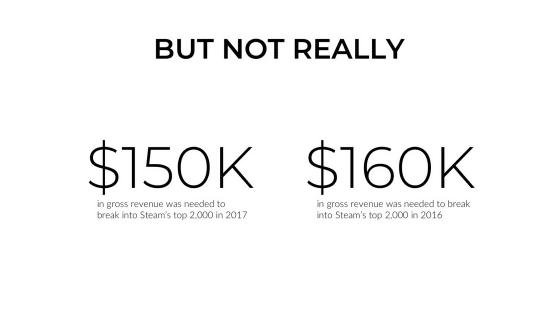
As mentioned earlier, there are situations where the number of "games that can not be sold" is also increasing, especially as "Steam Direct" introduced by Steam explosively increased the number of indie games. The graph below shows the number of times Steam users played indie games, but the number of indie games will be doubled from "2149 titles" in 2015 to "133624 titles" in early 2018 , While you can see that the number of indie games' play has increased only moderately. In other words, there is a large gap between the pace at which the indie game is released and the pace at which the number of times the game is played actually increases.

If you look at the graph of the number of titles released by month, you can see that it is on a sharp increase trend. Until the year 2013, the number of monthly incremental growth started to increase at the time when the game developer support program "Greenlight" was introduced, and the graph has risen sharply with the introduction of "Direct".
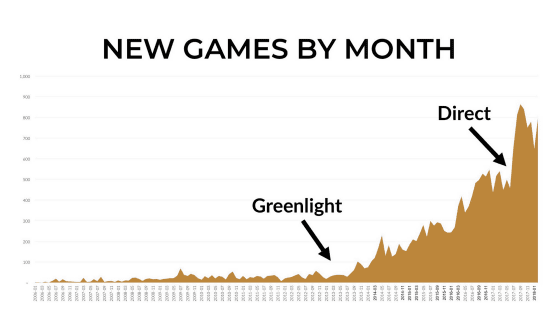
As mentioned above, the number of titles sharply increased in 2017. The title number "7696 books" released in 2017 accounts for 39% of the whole Steam, and the number of titles released even in September of the same year counts 864 books. With the introduction of Steam Direct, the rate of increase compared with the same month of the previous year has reached 55%.
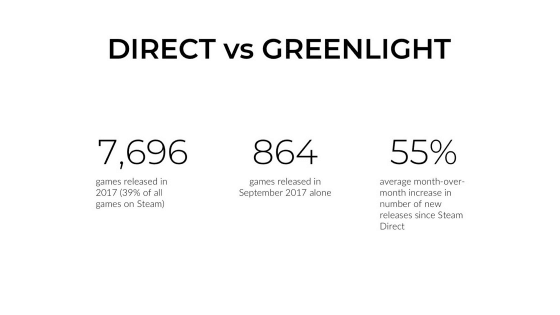
The graph below shows the maximum amount of games sold at Steam plotted for each price range. The title concentrates at 9.99 dollars (about 1100 yen), and it can be said that this is "the most expensive sweet spot".
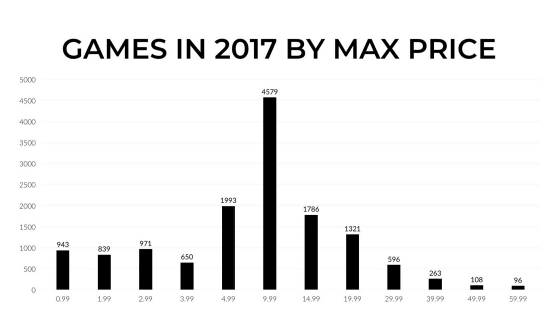
However, it does not mean that "9.99 dollars" is the most profitable price range. When plotting the number of sales of the game for each price range, you can see that the game with the price range of 29.99 dollars (about 3200 yen) is sold the most. Nonetheless, this graph is heavily influenced by monster titles "PUBG" whose price is just $ 29.99.
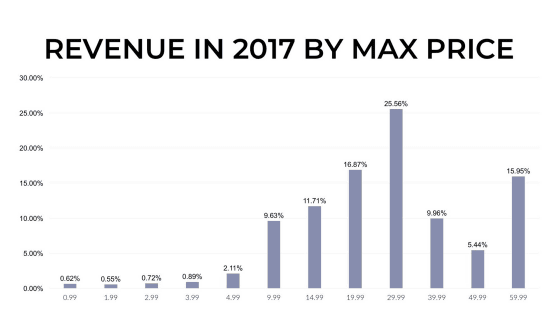
So, with a graph that excluded PUBG, it was said that 19.99 dollars (about 2100 yen) and 59.99 dollars (about 6400 yen) are "selling points" with such feeling.
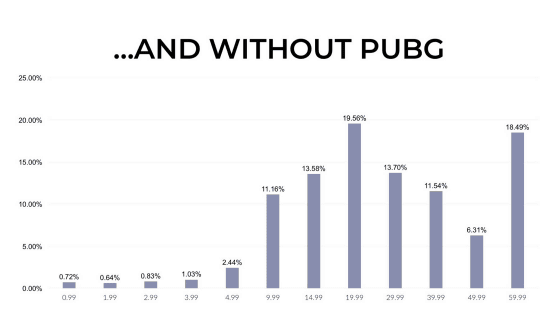
As of February 2018, it is clear that 64% of users using Steam have set simplified Chinese in the language setting of the PC. On the other hand, only 18% set English, and now you can see that most of the users are occupied by people using Chinese. Interestingly, however, Steam is officially recognized as an operation in China and is only recognized in Hong Kong. Therefore, depending on future trends in the Chinese government, Steam may not be greatly affected.
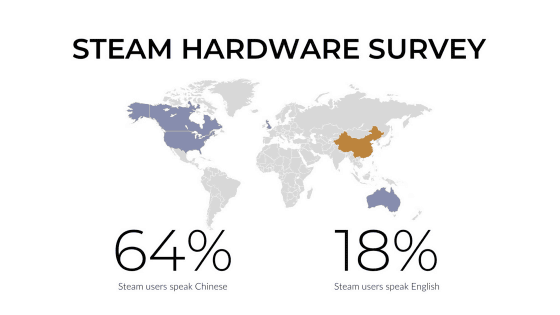
Graph of number of players and game titles in China is like this. Although the number of players has greatly increased with the advent of PUBG, the number of titles purchased by one player has not changed.
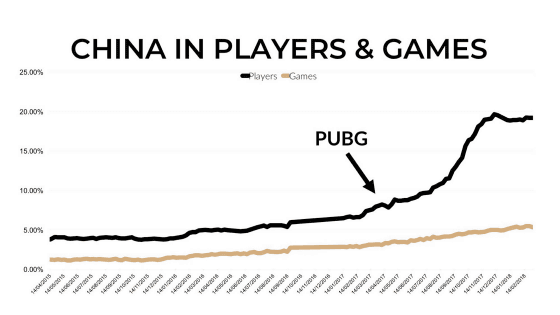
Strictly speaking, the numbers so far are based on "the number of machines on which Steam is installed". Meanwhile, taking statistics on the basis of "actual number of players", you will see a completely different landscape. Of the total active players in Steam, the percentage of Chinese players is 19.5%. This is far from the above-mentioned "64%" number, but the reason is that there is "Internet cafe". By installing Steam on a large number of machines placed in a net cafe, I was knocking out numbers that accounted for half of the world. Also, if you look at the number of games owned by Chinese players, you can see that 5.4% of the world is gathering in China.
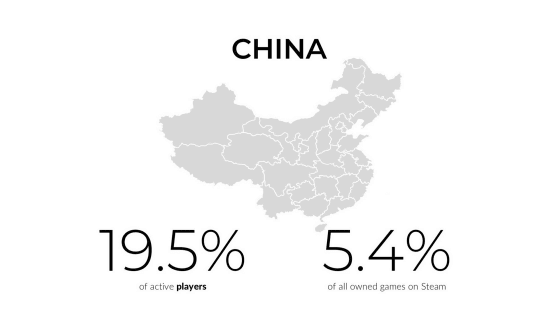
The share of the number of players in the US shows a gradual declining trend.
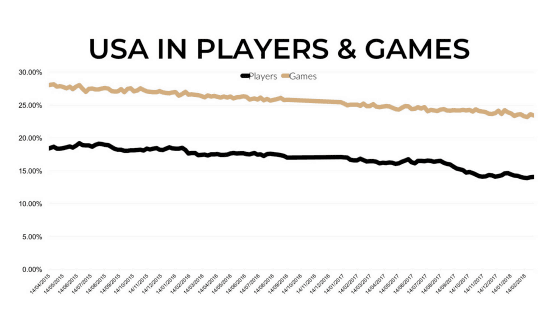
As with the above-mentioned China, when looking at the active plier player base, the number was found to be 13.9%, which is not so different from that of China. On the other hand, you can see that the number of games owned by American players is 23.3% of the whole world.
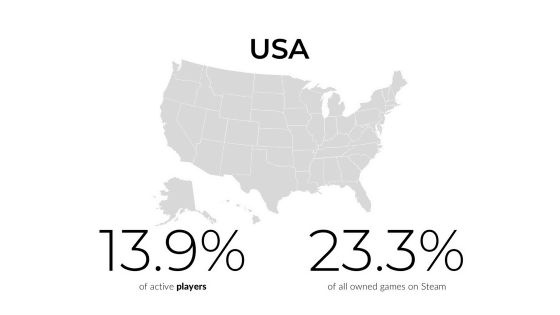
In other words, you can see that an average American player has six times more games than Chinese players.
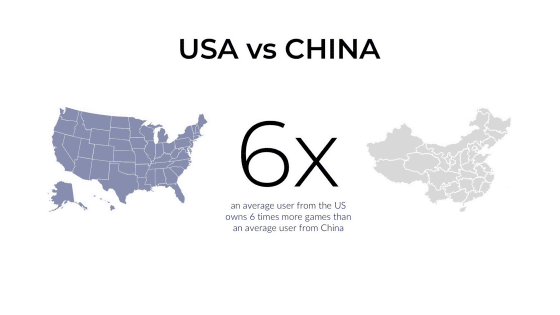
However, it is also known that the time to play PUBG in one week is longer than the double score, "16 hours" for Chinese compared to "7 hours for Americans".
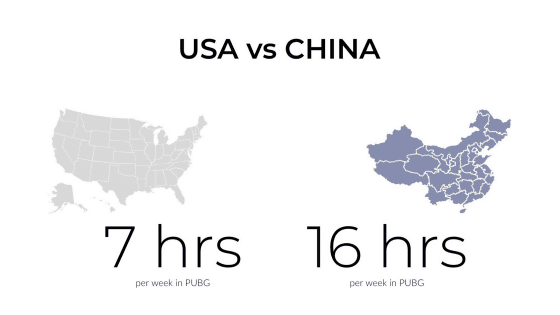
In terms of the number of people playing indie games (left), China and Russia are ranked in next to the first place in the United States. However, in these areas, it is said that many indie games are sold because special price is set, and if you look at the amount actually consumed for purchasing (right), it will be in 8th and 9th place You can see that it ranks down.
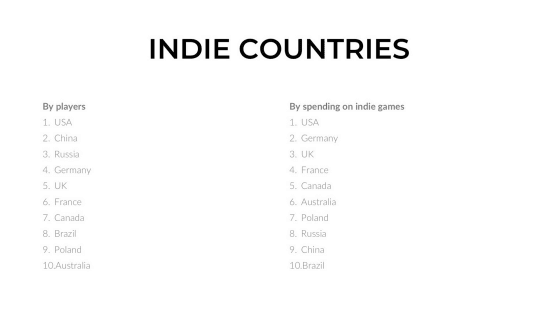
◆ Summary
From these data, Galyonkin concludes that 2017 has become a very good year for Steam. Meanwhile, for indie game developers, it is said that it was a tough year, as the unit price of the game declined, and the title became hard to play due to the flooding.
Related Posts:
in Web Service, Game, Posted by darkhorse_log







